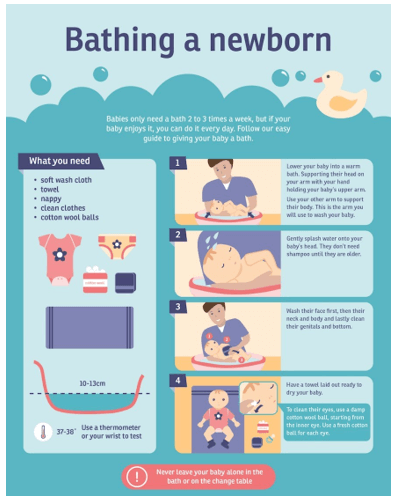A nurse at a long-term care facility is reviewing the plan of care for a client who has a prescription for mitten restraints. Which of the following tasks should the nurse assign to an assistive personnel?
Evaluate the need for the client to remain in mitten restraints.
Assist the client with range-of-motion exercises of the hands.
Instruct the client's family about the purpose of mitten restraints.
Determine the circulation status of the affected extremities every 2 hr
The Correct Answer is B
Range-of-motion exercises can be safely performed by assistive personnel under the supervision and direction of the nurse. It helps to maintain the mobility and function of the client's hands while in restraints.
Nursing Test Bank
Naxlex Comprehensive Predictor Exams
Related Questions
Correct Answer is C
Explanation
Explanation:
Sponge baths are recommended until the umbilical cord stump falls off, which typically occurs within the first two weeks of life. After that, the baby can be immersed in water for a regular bath.
Using talcum powder is not recommended as it can be harmful to the baby's respiratory system if inhaled. Mild, pH-balanced soap should be used instead of alkaline soap to avoid irritating the baby's delicate skin.
The bathwater temperature should be around 98 degrees Fahrenheit and not hoter than 100 degrees Fahrenheit to prevent burns.

Correct Answer is C
Explanation
Using a cool-mist vaporizer in the baby's room can help provide moisture and relieve nasal congestion, especially during cold or dry weather. It can help ease breathing and improve the baby's comfort.
"I will leave the plastic covering on the crib mattress": This statement is incorrect. The plastic covering should be removed from the crib mattress before placing the baby in the crib. The plastic covering poses a suffocation risk and should not be used.
"I will lay my baby's head on a pillow while he is in the crib": This statement is incorrect. Pillows should not be used in the crib for infants. They increase the risk of suffocation and can pose a hazard to the baby. The crib should be free of pillows, blankets, stuffed animals, or any other loose items.
"I will leave my baby's bib on while he is sleeping": This statement is incorrect. Bibs should be removed before placing the baby in the crib or while the baby is sleeping to prevent the risk of suffocation. Loose items around the baby's neck can pose a strangulation hazard.
Whether you are a student looking to ace your exams or a practicing nurse seeking to enhance your expertise , our nursing education contents will empower you with the confidence and competence to make a difference in the lives of patients and become a respected leader in the healthcare field.
Visit Naxlex, invest in your future and unlock endless possibilities with our unparalleled nursing education contents today
Report Wrong Answer on the Current Question
Do you disagree with the answer? If yes, what is your expected answer? Explain.
Kindly be descriptive with the issue you are facing.
